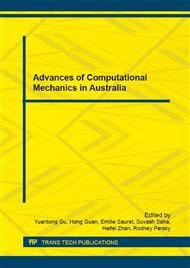p.23
p.30
p.36
p.42
p.48
p.54
p.61
p.67
p.73
The Influence of Incoming Boundary Layer on the Flow around the Surface Excrescence
Abstract:
This paper is concerned with the accurate prediction of parasitic drag due to excrescences introduced by structural repairs to aircraft wings and fuselage. Numerical computations are carried out to quantify the effect of isolated surface excrescences in a turbulent boundary layer on a flat plate. Both step excrescence in 2-D domain and wall-mounted hexahedron in 3-D domain are considered in the investigation. Various approaches for calculating drag coefficient increments for wing repair plates are presented. Menter's Shear Stress Transport (SST k-ω) turbulence model is employed here for its accurate prediction of aeronautics flows at typical repair locations with strong adverse pressure gradients and separation. Solutions are obtained via a high-order numerical scheme and an implicit time-marching approach on a multi-block structured mesh. A grid resolution study was carried out to confirm the accuracy of the computations. From the results curves are drawn showing the variation of parasitic drag components for a range of controlled speed (Mach 0.1 to 0.8), local Reynolds number (104 to 107) and the height of excrescence (y+=102 to 104).
Info:
Periodical:
Pages:
48-53
Citation:
Online since:
July 2016
Authors:
Keywords:
Price:
Сopyright:
© 2016 Trans Tech Publications Ltd. All Rights Reserved
Share:
Citation:


